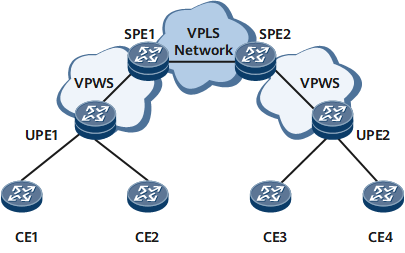Configuring VPWS Accessing VPLS
This section describes how to configure VPWS accessing VPLS on an HVPLS network where UPEs do not support VPLS.
Usage Scenario
As shown in Figure 1, when UPEs do not support VPLS, you can configure VPWS on UPEs and VPLS on SPEs to implement end-to-end service bearing. From the perspective of an SPE, a VPWS or VPLS PW established statically or established using LDP from the SPE to a UPE is a spoke VPLS PW that does not follow the split horizon rule. From the perspective of a UPE, a PW established from itself to an SPE is a VPWS LDP PW. Similarly, in a common VPLS scenario, if PEs do not support VPLS, you can configure VPWS accessing VPLS on the PEs. For details, see VPWS Accessing VPLS.
Pre-configuration Tasks
Before configuring VPWS accessing VPLS, complete the following tasks:
Configure IP addresses and IGP routes on UPEs, SPEs, and Ps.
Configure LSR IDs and enable MPLS and MPLS LDP on UPEs, SPEs, and Ps.
Enable MPLS L2VPN on UPEs and SPEs.
Establish tunnels between SPEs and between UPEs and SPEs for data transmission.

Configure a remote LDP session if SPEs are not directly connected or if a UPE and an SPE are not directly connected.
- Configuring Static VPWS Accessing VPLS
- This section describes how to configure static VPWS accessing VPLS when UPEs do not support VPLS.
- Configuring Dynamic VPWS Accessing VPLS
- This section describes how to configure dynamic VPWS accessing VPLS when UPEs do not support VPLS.
- Verifying the Configuration of VPWS accessing VPLS
- After configuring VPWS accessing VPLS, check VPWS and VPLS information, such as PW, outbound interface, VSI, and tunnel policy information.
